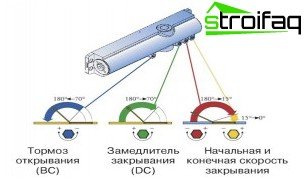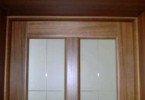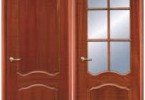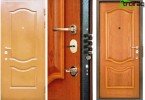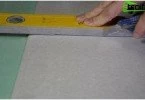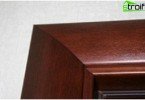Installation and adjustment of the door closer
The door closer is a mechanism that provides smooth closing of doors in automatic mode. Proper installation and adjustment of the door closer ensures the correct operation of the locking devices and helps to maintain the optimum temperature in the room, keeping warm in the winter and cool the air conditioner in the summer heat.
The prototype of a modern door closer is an ordinary spring, simply fixed to the door. Closing such a door was certainly accompanied by a strong bang, which brought a certain inconvenience.
Content
- Key parameters for choosing a door closer
- How to install the device on the door with your own hands
- Standard installation of a smooth finishing device
- Door closer adjustment
The closer is also based on a spring placed in a metal case, which is filled with special oil. To slow down and smooth the closing of doors, the principles of hydraulics were implemented: the conversion of the mechanical force applied at the time of opening to slow down the subsequent closing of the door.
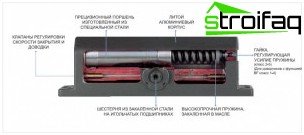
door closer
The closer operates according to the following, rather simple principle:
- at the moment of opening the doors a certain force is applied to them;
- the spring is compressed through the linkage, the piston and the output axis of the closer;
- the body part freed from the piston is filled with oil;
- at the moment of closing the doors, the spring gradually unclenches, and the oil flows to its previous position.
The door closer is adjusted using specially installed control valves that affect the closing speed..
Key parameters for choosing a door closer
Installation of closers is possible both on ordinary interior doors, and on external barriers or gates.
When choosing a closer, you should first pay attention to the following parameters:
1. The weight of the door and the dimensions of the door leaf
The main parameter of any closer is its power or, in another way, the force of closing doors. Therefore, the wider the door leaf and the heavier the door, the more power it should have. Sometimes, to increase efforts on especially large obstacles, it is necessary to install two door closers at once.
The normalization of the door closer is calculated on the basis of the European standard EN 1154, which defines door closers in seven different classes (EN1 – EN7). Following the recommendations of the standards, the EN1 class door closer is for narrow and light doors, and the EN7 class door closer is for wide and massive entrance barriers. When installing on ordinary internal and small external doors, it is recommended to use closers 3-5 classes.
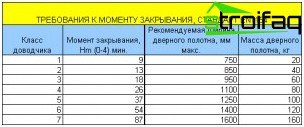
door closers classification
2. The ability to adjust the parameters of the closer
The main parameters for adjusting the closer can be noted:
- closing force;
- closing speed.
A number of mechanisms designed to solve additional problems are equipped with wider functionality:
- wind brake (Back Check), which protects the door from impacts against the wall during sudden opening or gusts of wind. At the same time, some models have a function for adjusting the angle of operation;
- delayed closing (Delay Action) allows you to delay the closing of the door for a short period of time, which is very convenient when carrying small loads;
- the function HOLD OPEN is the possibility of rigidly fixing the door in the open position; smooth adjustment of spring force.
3. Type of traction device
Depending on the installation conditions and the door structure profile, the closer is equipped with the following types of traction devices:
- standard traction device;
- device with a sliding rod;
- traction lock.
4. The method of mounting the closer
According to the installation method, the following types of closers are distinguished:
- for surface mounting when the device is mounted directly on door frame or canvas;
- for floor installation, when the closer is installed in the floor and can simultaneously serve as support hinges for doors;
- with a hidden type of installation, the closer is placed inside the door leaf.
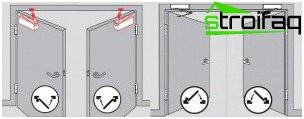
ways to install the closer
5. Operating temperature range
Installation of a door closer requires a mandatory consideration of operating conditions and possible differences in ambient temperature. Today, models with an interval from minus 35C to plus 70C appeared on sale. Closers designed to work in especially cold conditions – up to minus 45C.
6. Service life and protection against vandalism
The external door closer must have increased reliability and anti-vandal characteristics, as well as have a long service life.
Such parameters as reliability and service life are determined on the basis of the European standard EN 1154 and depend on the minimum number of door open-close cycles without compromising the quality of operational characteristics. According to the standard, the door closer must work out at least 500,000 cycles. In addition, the case of external closers must be made of durable materials that are not subject to corrosion.
7. Closer design
The external design of the closer is largely determined by its functional purpose. It can be miniature devices made in any color scheme, and massive steel structures in white, dark brown and silver-gray design.
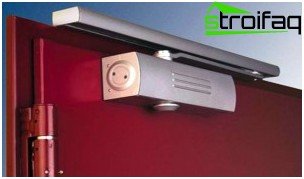
door closer design
There are also a number of additional parameters that you should pay attention to when choosing a door closer. This includes the frequency of operation of the door, the quality of the installed door hinges and fasteners, the presence of electromechanical locks on the doors, and the presence of permanent drafts for external doors.
How to install the device on the door with your own hands
Regardless of the type of door and installation features, to install a door closer with your own hands you will need:
A. To install the door closer:
- mounting, corner and hanging platinum;
- mounting plate.
B. For the sliding channel:
- corner plate;
- mounting plate.
Before starting the installation of a door closer, it is necessary to pay attention to the door opening parameters.
It can be left-side or right-side doors that open both “from yourself” and “to yourself”.
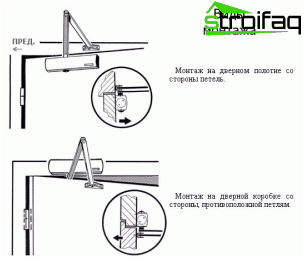
door closer installation
When installing the door closer from the outside of the door that opens inward, the device body must be located on the door leaf, and the base of the lever on the door frame.
With doors that open “away from you”, the door closer is mounted on the door frame, and the base of the lever is mounted on the door leaf.
ATTENTION! Do not use the door closer as a door opener! To do this, it is recommended to use special door stops. It is also necessary to ensure that children do not ride on automatically closing doors.
Standard installation of a smooth finishing device
The standard equipment of the closer includes:
- closer;
- fasteners;
- lever arm;
- wiring diagram.
For the convenience of users, most door closers manufacturers attach a life-size fastening scheme. This allows you to use it to accurately mark the mounting of the closer.
- Having chosen the optimum angle of opening the door from the table attached in the description, and using the diagram, it is necessary to mark 4 holes for the closer and 2 holes on the door frame.
- Drill marked holes.
- Next, on the door jamb, fasten the closer lever with screws.
- Having placed the main lever on the square axis of the closer, fix it with the fixing screw.
- Attach the door closer carefully. In this case, the nut that regulates the force of the spring should be located opposite the door hinge.
- It is necessary to adjust the length of the variable lever so that it is perpendicular to the door frame, and connect it to the main lever.
- Fasten the small decorative cover directly under the square axis of the closer housing.
- Adjust all required door closer parameters.
Door closer adjustment
High-quality installation of a door closer is the key to the effectiveness of its work, so adjustment of the door closer should be carried out immediately at the time of installation of the mechanism. A properly mounted door closer will allow the door leaf to close smoothly and without jerking.
However, during operation, there is a need for additional adjustment. To eliminate malfunctions in the operation of the closer, it is recommended to use the following tips:
- If the doors are closed too slowly or, on the contrary, too quickly, it is necessary to adjust the adjustment valve of the closer.
- To increase or decrease the “catch” speed, the second valve adjustment is used..
- The spring tension and door opening angle are adjusted using the adjusting nut.
- To keep the door open, just tighten the lock. To remove the fix, you just need to close the door.
door closer adjustment
All adjustments are made in the direction of or counterclockwise. The direction of movement will depend on the desired result..
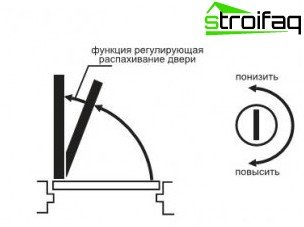
door closer adjustment
ATTENTION! In order for the door closer to work efficiently, it is forbidden to support the door with foreign objects or hang heavy things on them.
Twice a year, it is recommended to change the grease in the joints of the lever joints. Also, every six months it is necessary to adjust the closer.


